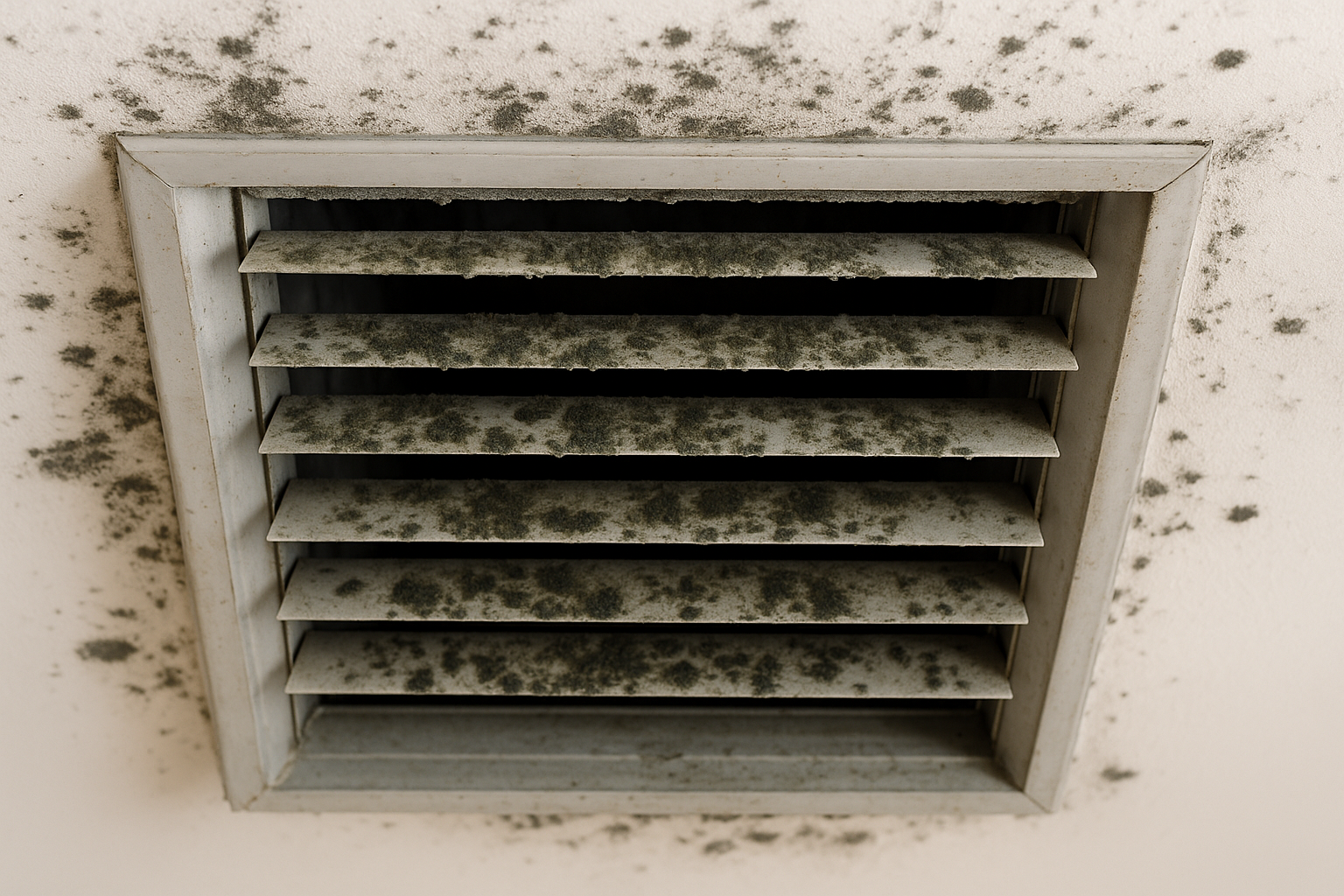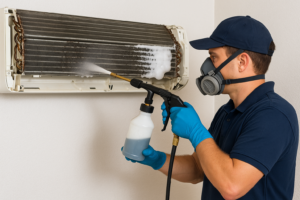If you’ve recently noticed a musty smell when your AC turns on, seen black or green spots around vents, or felt the air inside your home becoming “heavy,” you may be dealing with mold in AC ducts and vents in Dubai—one of the most common HVAC problems in the UAE’s humid, dusty climate.
As a Dubai-based AC duct cleaning and mold removal specialist with over 10 years of hands-on experience in Dubai Marina, JLT, JVC, Palm Jumeirah, Al Barsha, Mirdif, Arabian Ranches, Damac Hills, and Sharjah/Ajman communities, I can confirm:
Dubai’s humidity + 24/7 cooling + desert dust = perfect mold growth conditions inside AC systems.
This guide will show you EXACTLY how mold develops, how dangerous it can be, how professionals remove it, what the costs are, and how to prevent it.
H2: What Causes Mold in AC Ducts and Vents in Dubai?
Mold inside HVAC systems is almost always caused by a mixture of humidity, moisture, and dust—three conditions that Dubai has more than enough of.
Let’s break down the primary causes.
1. Dubai’s High Humidity (55%–95%)
Dubai’s humidity levels frequently stay above 70%, especially near the coast and marina areas.
When humid indoor air meets chilled AC ducts, condensation forms, creating moisture inside the ducts.
According to ASHRAE, moisture + darkness = rapid mold activation.
2. 24/7 Air Conditioning Usage
In Dubai households, AC systems run 20–24 hours per day, causing:
- continuous coil moisture
- damp drain trays
- cold, moist duct interiors
If drain lines are partially blocked, water backs up and travels into ducts—resulting in mold growth within 48 hours.
3. Dust Storms (Shamal Winds) & Outdoor Pollutants
Dust from sandstorms enters homes through:
- tiny window gaps
- door air leakage
- balconies
- building ventilation shafts
- parking ducts
Dust acts as organic food for mold spores.
JVC, JLT, IMPZ, and Mirdif areas experience this heavily.
4. FCU Condensation Leaks
Many apartments in Dubai Marina, JLT, Business Bay, etc., have old or poorly maintained FCUs.
Common issues:
- clogged drain lines
- water pooling inside units
- leaking drain trays
- low refrigerant causing coil freeze/defrost cycles
Any water dripping into ducts promotes mold.
5. Poor Duct Insulation in Older Dubai Buildings
Buildings from 2000–2015 often have fiberglass insulation that has degraded.
Results include:
- duct sweating
- moisture buildup
- warm/cold air mixing
This accelerates mold growth.
6. Poor Ventilation + Closed Windows
Modern Dubai apartments are hermetically sealed.
No airflow = mold spores remain inside and multiply.
H2: Why Mold in AC Ducts Is Dangerous (Health + AC Performance)
Let’s look at both health and mechanical risks.
1. Health Risks (CDC Findings)
According to the CDC, mold exposure can cause:
- sneezing & coughing
- sinus congestion
- asthma attacks
- headaches
- itchy/watery eyes
- throat irritation
- worsened allergies
In children and seniors, the effects can be stronger.
Important:
We don’t make medical claims — but we reference CDC evidence.
2. Indoor Air Quality Problems
Mold spores circulate through every vent, contaminating the entire home.
Common signs:
- musty or damp odor
- air feels heavy or stale
- occupants feel better outdoors
- black or green dust on furniture
3. Higher DEWA Bills
AC consumes 60–70% of home electricity in Dubai.
Mold restricts airflow, causing:
- longer cooling cycles
- higher power consumption
- reduced cooling efficiency
Even 10–20% airflow restriction significantly increases energy use (ASHRAE data).
4. AC System Damage
Mold can clog:
- evaporator coils
- blower fan
- duct walls
- return plenum
- filters
- drain lines
This results in expensive repairs if left untreated.
H2: Signs You Need Professional Mold Inspection in Dubai
These are the most common mold symptoms we see across Dubai homes:
✔ Musty smell from vents
✔ Black or green spots around vents
✔ Dust blowing out when AC starts
✔ High humidity inside the house
✔ Increased DEWA bill
✔ Water dripping from the AC vent
✔ Family members experiencing allergies indoors
✔ White/grey residue around grills
✔ Weak airflow in some rooms
✔ AC making unusual noises
If you see 2 or more, mold is highly likely.
H2: Step-by-Step Professional Process (Dubai HVAC Method)
This is the same NADCA-aligned process we use across Dubai, Sharjah, and Ajman.
⭐ 1. Full System Inspection
We check:
- supply & return vents
- duct interior
- FCU coil
- drain tray
- drain line
- duct insulation
- moisture levels
- mold patterns
Before photos are captured for transparency.
⭐ 2. Negative Air Pressure Setup
A powerful negative air machine is connected to the duct system to pull contaminants safely into a sealed HEPA chamber.
⭐ 3. HEPA Vacuuming
Commercial-grade HEPA vacuums remove:
- dust
- mold spores
- debris
- sand buildup
- organic material
⭐ 4. Rotary Brush Mechanical Cleaning
A flexible rotary system scrubs deep inside ducts, removing all mold colonies and buildup.
⭐ 5. Coil Deep Cleaning
We use:
- eco-safe coil cleaners
- steam (if needed)
- micro-brush tools
This removes mold from wet coil surfaces.
⭐ 6. Drain Line Flushing
We flush the drain pipe with:
- pressure
- anti-algae solution
- suction (if needed)
This prevents water backup.
⭐ 7. Anti-Microbial Treatment (Dubai Municipality Approved)
A safe, child- and pet-friendly disinfectant is applied across:
- ducts
- FCU
- drain tray
- vents
This removes remaining spores.
⭐ 8. Sanitization & Fogging
A fine disinfectant mist spreads throughout the duct system.
⭐ 9. Final Inspection + After Photos
We show clients the “before and after” results for full transparency.
H2: Pricing & Cost Factors for Mold Removal in Dubai
Costs depend on:
- number of AC units
- duct length
- ceiling height
- access issues
- severity of mold
- villa vs apartment
- insulation condition
Studio: AED 350–500
1 Bedroom: AED 450–650
2 Bedroom: AED 700–1,100
3 Bedroom: AED 1,200–1,600
Villas: AED 1,500–3,500
Coil Deep Cleaning: AED 150–350
Drain Line Flush: AED 80–150
Final price is always confirmed after inspection.
H2: Prevention Tips — Dubai HVAC Expert Advice
These are the tips we give every client:
✔ Clean filters every 2–3 weeks
✔ Keep humidity 45–55%
✔ Use AC on AUTO mode
✔ Keep windows closed during sandstorms
✔ Don’t block vents
✔ Keep indoor temperature 23–25°C
✔ Schedule annual AC maintenance
✔ Check for FCU leaks every few months
These small steps prevent 80% of mold re-growth cases.
H2: Frequently Asked Questions (FAQs)
1. Is mold in AC ducts dangerous?
It can irritate sinuses and worsen allergies (CDC reference), but every home reacts differently.
2. How long does duct mold removal take?
1–3 hours depending on property size.
3. Can mold return?
Only if moisture problems are not fixed.
4. Do you use strong chemicals?
No — only Dubai Municipality–approved safe disinfectants.
5. How often should ducts be cleaned?
Every 1–2 years in Dubai.
6. Is duct cleaning noisy?
Mild noise — not disturbing.
7. Do you provide before/after photos?
Yes, always.
Conclusion
Mold in AC ducts and vents in Dubai is extremely common due to humidity, dust, and constant cooling — but with proper inspection, professional cleaning, and moisture control, it can be completely resolved.
A clean HVAC system means:
- cleaner air
- lower DEWA bills
- better cooling
- healthier home environment
If you’re unsure whether you have mold or not, a quick inspection can prevent costly repairs later.
⭐AirChill AC Maintenance & Duct Cleaning LLC
For professional duct cleaning, mold removal, coil cleaning, and AC hygiene:
📞 WhatsApp / Call: (Add your number)
📍 Dubai • Sharjah • Ajman
🛠 NADCA-aligned hygiene process
📸 Before/after photos provided





